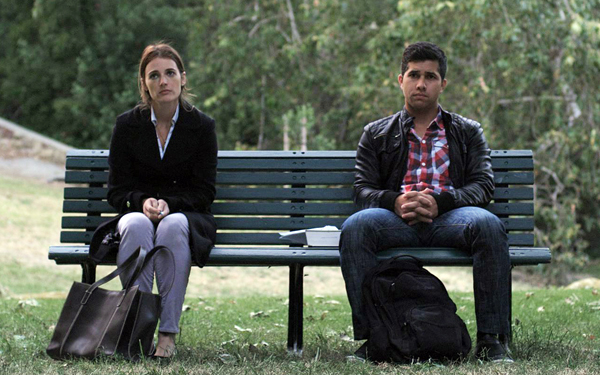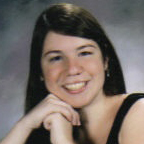By Michelle Houle.

Ann LeSchander. Image by Heather Sullivan
In Ann LeSchander’s first feature film The Park Bench, the classics of American Literature serve as a backdrop to the main characters’ romance.
Mateo and his tutor, Emily, are assigned to work together by the university. As they pore over the works of F. Scott Fitzgerald and Edith Wharton, they reveal their deepest fears and dreams, and begin to fall in love. These confessions are brought to life in beautiful sequences animated by Natia Nikolashvili.
Creative Screenwriting talked to LeSchander about The Park Bench, mixing live action with animation, and finding the stories you want to tell.

Nicole Hayden as Emily and Walter Perez as Mateo in The Park Bench. Image by Gareth Taylor
What was your original inspiration for the film?
I was originally inspired by those moments when you’re forced into a relationship. I thought about different experiences I had. In an acting class, you get your scene partner and you are forced to meet two times a week, four times a week, and then suddenly you know everything about that person.
This idea of a tutor and her student discussing American Literature initiated the story. I don’t think you can read those books and talk about them without revealing a little bit about yourself, and I thought this would be an opportunity for them to piece by piece reveal themselves to each other.
I was trying to come up with a concept that was doable and simple scale-wise, and hoping the concept would be engaging and interesting for an audience to follow.
What scene did you find the hardest to write?
The scene where Mateo asks Emily not to get married. That scene was challenging because I had to figure out a way where he makes this tremendous ask. There were a lot of emotional moments that had to happen. Let’s put it all on the line.
Emily had to make it clear she was not going to meet him. It had to be volatile enough so that Mateo felt spurned. For him to feel like their relationship was over, it was never going to happen.

Ann LeSchander with cinematographer Gareth Taylor on set of The Park Bench. Image by Joe Puhy
How do you inhabit your characters’ voices when you write?
Emily’s voice came easy to me. She’s an exaggerated version of me.
I did a lot of research to figure out who Mateo could be and came up with the idea of this character because my daughter was attending Spanish immersion school. There was a mandate that the school had to be 50% native Spanish speakers, so I saw these families raising first generation children. It was an eye-opening experience for me and a lot of the things that I witnessed or a lot of the people that I met ended up in Mateo’s character. In a lot of ways, he’s just a guy and she’s a girl. They butt heads often.
I liked how you included animation mixed with the live action. Can you talk about the screenwriting choices involved?
It’s interesting because often in my short films, and this is my first feature, I realized I always have a moment with a monologue. I like the idea of monologues because I think they’re very cinematic, and the writing can be more poetic and revealing.
I thought the characters will each have a monologue, something revealing. Then it morphed into this idea of, “What if they have more than one? What if this is a story about stories? What if they have their own stories that they want to share and they’re still revealing? Here’s an opportunity for them to become the narrator of their own story. What will we see and how will we show that?” I thought it would be a great opportunity to get off the bench.
I wanted it to be mixed media – some monologues would be animated and others would have a Super 8 style.
I think people will go along on the ride if we can make it engaging and we can tell these stories in a cinematic way. I found my wonderful animator who helped bring it to life.

Walter Perez as Mateo and Nicole Hayden as Emily in The Park Bench. Image by Gareth Taylor
How would you approach your next screenplay differently from what you’ve learned from doing this film?
I’m not going to be able to repeat any of the same story tropes. I’m going to have to move on and have more locations and more plot.
My next film will have more screenwriting structure, but I still hope to keep the style of the dialogue very similar.
What have you learned from directing your own material?
I enjoy it. I have a sense of who these characters are and how they sound. It’s the care with which I feel about these characters I’ve created that I think makes me that more attentive to the making of the movie. It’s a great joy for me to be able to direct something that I have written.
Are you working on any new projects?
I have a screenplay now that I am still working on, though it’s not completed. It has more than one location. It’s a fish out of water story. It doesn’t stray too far in terms of my sensibility.
Now that I think I’ve found where my sensibility lies and what I feel about how people talk to each other and relate to each other, I’ve discovered people talk around things. I don’t think they talk to each other. I think they tease each other and joke with each other. I think that’s a big part of what I think is real. I’ll probably continue writing in that vein as I move along.

Nicole Hayden as Emily and Walter Perez as Mateo in The Park Bench. Image by Gareth Taylor
How do you prepare before you go into a pitch meeting?
I’m a firm believer in practicing my pitch from start to finish. I always know what I want to talk about because I have a pretty good idea of what they’re going to ask.
I’m ready to talk about my project’s main points. I’ve synopsized them in my head and I’ve written it out.
What advice would you give to aspiring screenwriters?
I don’t want to use the cliché, “Write what you know.” I think you should find your voice. Hopefully that can inform whatever you’re writing in whatever genre you’re writing. If you find your voice, it’ll actually make it easier for you.
I worked on a psychological thriller with my writing partner. It was very dark and heavy. But there was something in me that said, “What are the stories you really want to tell, Ann? What do you want to share with the world?”

